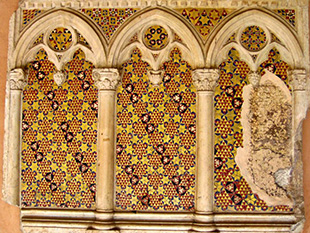












The name derives from Cosmati, one of the groups of marble craftsmen who created works by taking marble from ancient Roman ruins, and arranging the fragments in geometrical decorations. It is also known to some postmedieval scholars as opus alexandrinum.
Among the churches decorated in cosmatesque style in Rome, most noteworthy are San Lorenzo fuori le Mura, San Saba, San Paolo fuori le Mura, Santa Maria in Aracoeli, and Santa Maria in Cosmedin. Outside Rome, Anagni and Ferentino contain remarkable cosmatesque works. Also, Cosmati built innovative decoration for the church of Civita Castellana. The style spread to the rest of Europe: the high altar of Westminster Abbey, for example, is decorated with a cosmatesque marble floor.
Style
This peculiar style of inlaid ornamental mosaic was introduced into the decorative art of Europe by a marble-worker named Laurentius, a native of Anagni. Laurentius acquired his craft from Greek masters and for a time followed their method of work. However, early in his career, he freed himself from Byzantine traditions and influences, and worked along original lines and evolved a new style of decorative mosaic, vigorous in colour and design. He invariably employed this in conjunction with plain or sculptured marble surfaces, as a decorative accessory to some architectural feature.
As a rule Laurentius used white or light-coloured marbles for his backgrounds. These he inlaid with squares, parallelograms, and circles of darker marble, porphyry, or serpentine, surrounding them with ribbons of mosaic composed of coloured and gold-glass tesserae. These harlequinads he separated one from another with marble mouldings, carvings, and flat bands, and further enriched them with mosaic.
Works
Laurentius' earliest recorded work was executed for a church at Fabieri in 1190, and the earliest existing example is to be seen in the church of Santa Maria in Aracoeli at Rome. It consists of an epistle and gospel ambo, a chair, screen, and pavement. In much of his work he was assisted by his son, Jacobus, who was not only a sculptor and mosaic-worker, but also an architect of ability, as may be seen by the architectural alterations he carried out in the cathedral of Civita Castellana, a foreshadowing of the Renaissance. This was a work in which other members of his family took part, and they were all followers of the craft for four generations. Those attaining eminence in their art include: Laurentius (1140-1210); Jacobus (1165-1234); Luca (1221-1240); Jacobus (1213-1293); Deodatus (1225-1294); Johannes (1231-1303).
Early history
Although the Cosmati of 12th Century Rome are the eponymous craftsmen of the style, they do not seem to have been the first to develop the art. A similar style may be seen in the pavement of the Benedictine abbey of Monte Cassino 1066-1071, built using workers from Constantinople. It is also likely that the geometric style was heavily influenced by Arabesque art, which, due to the Islamic ban on representation of the figure, was also heavily geometric.
De Ferranti's experience at recreating Cosmatesque Floors and Walls is unsurpassed. Examples of our work can be seen by clicking here.
By Appointment
DE FERRANTI
South Park Studios - Suite 10
88 Peterborough Road, London SW6 3HH
United Kingdom